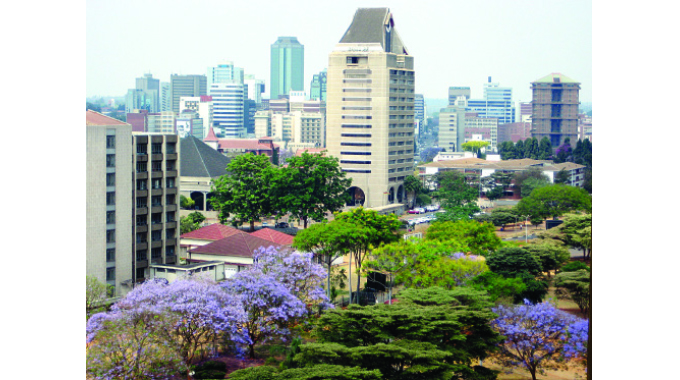
Fortunes Matutu
Population growth in urban areas has seen an increase in the demand for space for houses and other infrastructure which has resulted in increased cutting down of trees. The situation is made worse by increased demand for fuel wood and space for agriculture, further increasing deforestation in urban areas. The loss and degradation of urban forests or green spaces adversely affects the ecosystem and consequently human lives.
Trees are an important component of any environment because they provide a wide range of benefits including timber, non-timber products and various ecosystems services. Urban forests can help tackle some of the problems that are inherently a part of towns as well as reduce the city budgetary constraints.
Urban forests can be defined as groups of trees and individual trees located in urban areas. They include forests, street trees, trees in parks, gardens and wetlands.
Urban forests and trees contribute to sustainable urban development by improving environmental quality and consequently the quality of life in the cities. However, the concept of urban forestry is poorly understood and often neglected as evidenced by declining greenery in the urban areas. Some people scoff at the idea of urban forestry and believe trees are not meant to be in urban areas but in reality, humanity cannot exist in a concrete jungle.
In failing to understand how urban forestry supports the society we are rapidly compromising the environments’ ability to sustain life.
Every year millions of people die from outdoor pollution worldwide- more than ever before. Many more people are suffering from respiratory problems because of the dirty air they breathe in the cities. Houses and infrastructure are at increased risk from natural disasters caused by whirlwinds, floods and heat waves.
Zimbabwe formally launched its smart city blueprint named the Zimbabwe Smart Sustainable Cities Initiative in March 2018. The initiative lists healthy environment, access to clean water, beautification of the city and improved health delivery among some of the objectives to create smart cities. Trees contribute to smart cities by improving the livability through provision of timber, fruits and most importantly ecosystem services.
Trees improve air quality. Having more trees increases the amount of oxygen and makes the air quality better. The leaves serve to filter dust, ash, smoke and pollen which can be harmful to humans. Trees also absorb carbon dioxide and other harmful gases such as carbon monoxide, chlorofluorocarbons and nitrous oxide, through the pores on their leaves. This is the best means of reducing smog and fumes from vehicle exhausts and industrial processes.
Hard surfaces in urban areas makes flooding much more likely. The non-porous nature of urban building materials means that water runs off them into the drainage system. When there is excessive rainfall, the drains can become overwhelmed and flood the streets. Trees help prevent this by increasing infiltration; capturing and storing large amounts of water, both in their roots and in their canopy.
Urban wetlands absorb excess rainfall, reduce flooding and minimise subsequent infrastructure and economic damage. Urban wetlands also act as a filter for pollution improving water and air quality, and help moderate extreme city temperatures.
Concrete and other hard surfaces in urban locations absorb heat and reflect it back into the environment, significantly raising temperatures. Without anything to modify this effect, urban areas can become ‘heat islands’, which typically have an average temperature of five degrees higher than surrounding forested areas.
Through evapotranspiration trees release water vapor into the atmosphere. This added water vapor serves to lower air temperature, offsetting the heat increases from the hard urban surfaces. Trees also modify climate by providing shade, increasing humidity, and reducing wind speed. Trees are a necessary part of the urban landscape to modify and balance local climate conditions.
Trees are important in urban areas to reduce and block noise by absorbing both the original and refracted noise. They have long been used to block the noise from freeways as they pass settlements.
Trees improve the aesthetic value of urban areas through their form and flower colors. They can provide places to recreate and add value to real estate.
Urban forests should be a priority in municipal planning strategies, with the objective of maximising the benefits provided by trees and green infrastructure. If properly managed trees can make important contributions to the planning, design and management of resilient landscapes. The law provides that urban areas should have buffer zones, parks or green ways and are restricted from constructing along water ways and wetlands.
All urban forest design processes should start with the identification of suitable spaces and right species. The location for trees in urban areas include trees in streets and parking areas; trees in parks or gardens and trees planted in yards for fruits or as ornamental.
The right tree in the right place is a simple but effective rule for any urban forest design. A healthy urban forest begins with a clear understanding of the environment, infrastructure, social issues and the characteristics of the site. Without considering all these factors, urban trees may create problems for the community and city planners.
Careful planning prior to urban tree planting, and regular tree inspection and pruning can eliminate the problem of trees near buildings like cracking of roads and pavements water pipes. If not properly selected and maintained the trees may cause structural damage to buildings through to their roots or falling of whole trees or branches. Such problems can be avoided by careful selection of species and maintenance through pruning and pollarding and in some instances removal of old trees and replacing them.
Urban trees are highly important for the wellbeing and resilience of the urban populations and the environment. Let’s preserve urban trees and plant more.
-Fortunes Matutu is a forester with the Forestry Commission and has a special interest in social forestry.
